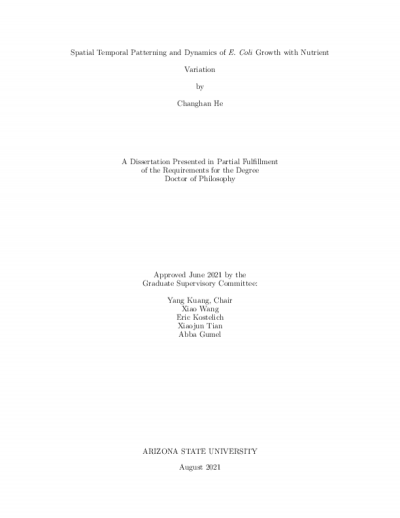
Description
Synthetic biology (SB) has become an important field of science focusing on designing and engineering new biological parts and systems, or re-designing existing biological systems for useful purposes. The dramatic growth of SB throughout the past two decades has not only provided us numerous achievements, but also brought us more timely and underexplored problems. In SB's entire history, mathematical modeling has always been an indispensable approach to predict the experimental outcomes, improve experimental design and obtain mechanism-understanding of the biological systems. \textit{Escherichia coli} (\textit{E. coli}) is one of the most important experimental platforms, its growth dynamics is the major research objective in this dissertation. Chapter 2 employs a reaction-diffusion model to predict the \textit{E. coli} colony growth on a semi-solid agar plate under multiple controls. In that chapter, a density-dependent diffusion model with non-monotonic growth to capture the colony's non-linear growth profile is introduced. Findings of the new model to experimental data are compared and contrasted with those from other proposed models. In addition, the cross-sectional profile of the colony are computed and compared with experimental data. \textit{E. coli} colony is also used to perform spatial patterns driven by designed gene circuits. In Chapter 3, a gene circuit (MINPAC) and its corresponding pattern formation results are presented. Specifically, a series of partial differential equation (PDE) models are developed to describe the pattern formation driven by the MINPAC circuit. Model simulations of the patterns based on different experimental conditions and numerical analysis of the models to obtain a deeper understanding of the mechanisms are performed and discussed. Mathematical analysis of the simplified models, including traveling wave analysis and local stability analysis, is also presented and used to explore the control strategies of the pattern formation. The interaction between the gene circuit and the host \textit{E. coli} may be crucial and even greatly affect the experimental outcomes. Chapter 4 focuses on the growth feedback between the circuit and the host cell under different nutrient conditions. Two ordinary differential equation (ODE) models are developed to describe such feedback with nutrient variation. Preliminary results on data fitting using both two models and the model dynamical analysis are included.
Details
Title
- Spatial Temporal Patterning and Dynamics of E. Coli Growth with Nutrient Variation
Contributors
- He, Changhan (Author)
- Kuang, Yang (Thesis advisor)
- Wang, Xiao (Committee member)
- Kostelich, Eric (Committee member)
- Tian, Xiaojun (Committee member)
- Gumel, Abba (Committee member)
- Arizona State University (Publisher)
Date Created
The date the item was original created (prior to any relationship with the ASU Digital Repositories.)
2021
Subjects
Resource Type
Collections this item is in
Note
- Partial requirement for: Ph.D., Arizona State University, 2021
- Field of study: Applied Mathematics
